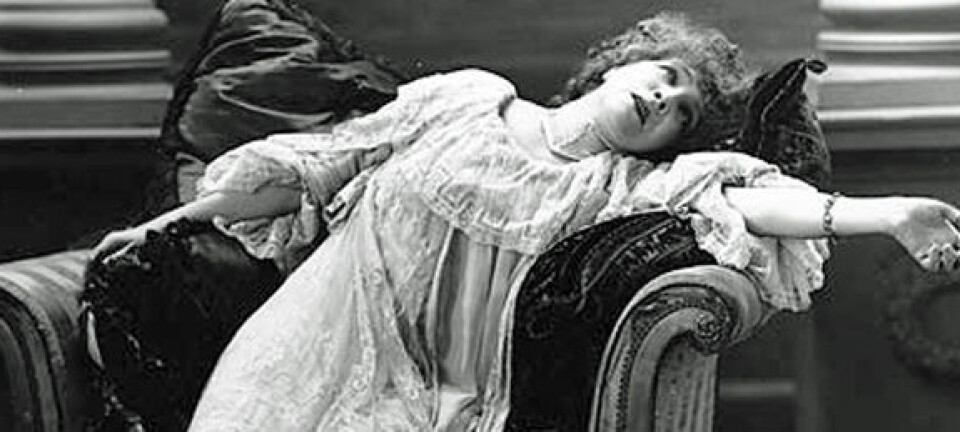An article from KILDEN Information and News About Gender Research in Norway

ME: The male disorder that became a female disorder
Previously long-term exhaustion was considered a male disorder caused by societal pressures. Today women comprise the majority of ME patients, and they feel that their condition is their own fault.
Denne artikkelen er over ti år gammel og kan inneholde utdatert informasjon.
Throughout history some people have suffered from a lack of energy and long-term, physical exhaustion. Today these symptoms are classified as myalgic encephalomyelitis (ME) or chronic fatigue syndrome (CFS).
It is commonly thought that chronic fatigue has mainly psychological causes and that it affects perfectionistic women who cannot live up to their own unreasonably high standards.
This has not always been the case. Just over 100 years ago it was primarily upper class men in intellectual professions who were affected. “Neurasthenia”, as the condition was called at the time, was a physical diagnosis with high status.
No longer legitimate
“The medical understanding of long-term exhaustion has changed. Previously the condition was viewed as a typically male disorder; now it is perceived as a typically female disorder. The diagnosis of neurasthenia, which has a male connotation, was changed to the ME diagnosis, which has a female connotation,” explains Olaug S. Lian, a sociologist and professor at UiT The Arctic University of Norway.
Together with Hilde Bondevik of the University of Oslo, Lian has studied how the view of women and perceptions of the body, gender and femininity in two different historical periods have been manifested in the medical understanding of long-term chronic fatigue.
“Long-term exhaustion was viewed as a legitimate disorder, a result of the heroic efforts of the upper class male. Today, it is a stigmatizing disorder, understood as an expression of women’s lack of ability to cope with their lives, a kind of breach of character,” says Lian.
Not only has the fatigued patient changed gender. Previously doctors believed that long-term exhaustion was a neurological, physical disorder, while today it is categorized primarily as psychological in nature. And while in the past, society was thought to be the cause of the disorder, today the individual is supposedly to blame.
What happened to cause this change?
Upper class diagnosis
At the end of the 1800s neurasthenia was the most widespread diagnosis for long-term exhaustion. Neurologists believed the condition was caused by a physical, neurological disease that affected the entire body, causing intense, long-term exhaustion.
Although women were also diagnosed with the disorder, the typical patient was a man, and not just any kind of man. He was “civilized, refined, and educated, rather than of the barbarous and low-born and untrained,” according to neurologist George Beard.
Society was to blame
Doctors at the time believed that the cause of the disorder could be found in a rapidly changing society – urbanization, industrialization and women’s entry into working life.
Quite simply, modern civilization ran roughshod over the nervous system of upper class men, who were overstimulated by too much pressure and activity and too little sleep and rest.
“It was regarded as both legitimate and understandable that even the ‘great men’ could fall apart as a result of long-term, difficult intellectual work. It was viewed as positive that the body sent signals when the burden was too great. The body was viewed as an electrical fuse box and the thinking was that it was better for one fuse to burn out rather than for the house to catch on fire,” says Lian.
Different genders, different causes
The comments about the diagnosis also revealed past understandings of biological gender differences. Women could get neurasthenia from sexual frustration, while men could get it from excessive sexual activity, including masturbation.
Moreover, there was a connection between gender and class.
“To simplify a bit, we can say that it was mainly middle class men and working class women whose diagnosis of neurasthenia was explained by overwork. For working class men it was due to sexual escapades, and for middle class women the cause given was heredity or ‘women’s issues’,” explains Lian.
The fall of neurasthenia
Neurasthenia lost its popularity as a diagnosis in the early 1900s. One reason for this was that psychiatry became a medical field in its own right.
“Psychiatry took neurasthenia with it and changed its definition from a physical to a psychological condition. Since women were regarded as psychologically weaker and therefore more disposed to mental illness, the disorder became a female problem,” says Lian.
Fight over definitions
Today ME is the most common name for the disorder, defined as long-term, intense exhaustion that cannot be directly linked to a well-defined illness and that does not disappear with rest. The condition is chronic, it cannot be cured with medical treatment and there is disagreement as to the cause.
“The lack of scientifically generated findings, medical explanations and effective treatment make ME a diagnosis with low status and low legitimacy within the medical community,” says Lian.
Currently the main theory is that ME results from an inability to handle stress and that perfectionistic people – the “good girls” – are especially at risk. The debate about how ME should be understood and explained is highly polarized, between those who believe that it is an illness caused by infections or vaccination and those who believe that ME has mainly psychological causes.
“I would like to see some humility about what we actually know about the disorder and not present value judgments as facts. Doctors must also be honest and acknowledge that we have very little hard-and-fast knowledge about this condition,” states Lian.
Blame and shame
The two historical periods have almost identical depictions of the phenomenon of long-term exhaustion, although the names are different. But there is one important difference: the disorder is no longer regarded as a legitimate, anticipated outcome of overwork.
“Today the medical community is searching for explanations of ME at the individual level. The ME patient is depicted as a woman with five-star goals and four-star abilities – with character traits that make it hard for them to cope with their own lives,” says Lian.
“When the entire problem is seen as the patient’s fault, the person experiences blame and shame because it is the patient, not society, who is the cause of the illness. It is therefore the individual who is responsible for coping with the illness, such as by changing her own thought patterns,” says Lian.
Wrong kind of tired
She points out that the ability to cope with one’s own life is an important value in Western culture. Mental disorders, however, are associated with weakness. The current understanding of long-term exhaustion is also linked to how we think about tiredness, according to Lian.
“There are strong norms for when you are allowed to be tired and worn out and how you are supposed to show tiredness in daily life. If you have been awake all night with a sick infant, you have a good reason to be tired at work. Other reasons are less legitimate. Workplace reports of absence never state that someone is at the psychologist, while it is completely acceptable to say that someone is at the dentist.”
“Being tired for the wrong reasons is seen as a sign of weakness, which must be overcome and hidden. It is in this context that we must understand the medical theories on a lack of coping ability and the objections of ME patients to these theories,” says Lian.
She believes such norms often make ME patients feel that the psychological explanation is a burden, although doctors do not necessarily mean for it to have this affect.
“What is it about the ME debate that makes the opposing sides so obstinate?”
“The doctors and patients talk past each other. The doctors think that an ME diagnosis is value neutral, but the patient hears ‘it’s my fault that I am sick and it’s my responsible to get better’. But although most people feel that mental disorders have lower value than somatic disorders, it is not a given that the doctors do,” says Lian.
Gendered explanation disappeared?
Although about three of four people who are diagnosed with ME today are women, the explicit, biology-based gendered explanations have disappeared from the debate, according to Lian.
“This may simply be because today we put greater focus on gender equality – which makes it less legitimate to claim that women are naturally inferior to men,” says Lian.
However, she believes that the ME diagnosis embodies a view of women that has long historical roots.
“The profile of the upper class woman from the 1800s who cannot cope with pressure and stress both inside and outside the home is still with us today,” says Lian.
Cultural bias
“How can your analysis contribute to the current debate about ME?”
“We show how the medical understanding of fatigue and lack of energy is impacted by the norms and values of society at large, for example, that medical knowledge reflects the view of women in our culture. Norms and values combine with biomedical knowledge in a way that makes it difficult to see what is what,” says Lian.
Translated by: Connie Stultz

































